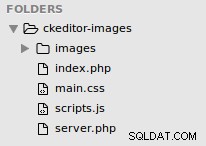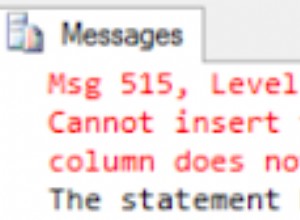Come menzionato in un commento sulla tua domanda precedente , il tuo secondo cursore non è limitato al dipendente trovato dal primo cursore perché non hai alcun collegamento tra di loro. Dove hai:
and employee_id = employee_id
... entrambi si riferiscono alla colonna della tabella, quindi non funge affatto da filtro. Hai assegnato lo stesso nome alla tua variabile locale, il che confonde abbastanza le cose, ma è comunque fuori dall'ambito:questo cursore non ha visibilità del valore della variabile impostato nel corpo principale della procedura.
Devi fare qualcosa come:
CREATE OR REPLACE PROCEDURE sp_run_employee_updates (p_date IN DATE) IS
update_sql varchar2(4000);
first_update boolean;
CURSOR c_employees IS
SELECT DISTINCT employee_id
FROM bi_employee_update
WHERE effective_date = p_date
AND executed = 'N'
AND activity_id = '0';
CURSOR c_updates(cp_employee_id bi_employee_update.employee_id%TYPE) IS
SELECT *
FROM bi_employee_update
WHERE effective_date = p_date
AND executed = 'N'
AND activity_id = '0'
AND employee_id = cp_employee_id
FOR UPDATE;
BEGIN
-- loop around all employees with pending records
FOR r_employee IN c_employees LOOP
-- reset the update_sql variable to its base
update_sql := 'UPDATE BI_EMPLOYEE SET ';
-- reset the flag so we only add the comments etc. on the first record
first_update := true;
-- loop around all pending records for this employee
FOR r_update IN c_updates(r_employee.employee_id) LOOP
-- add the comments etc., only for the first update we see
if first_update then
update_sql := update_sql
|| ' comments = ''' || r_update.comments || ''','
|| ' updated_by = ''' || r_update.changed_by || ''','
|| ' updated_on = ''' || r_update.changed_on || ''','
|| ' effective_date = ''' || r_update.effective_date || '''';
first_update := false;
end if;
-- add the field/value from this record to the variable
update_sql := update_sql || ', '
|| r_update.column_name || ' = ''' || r_update.new_value || '''' ;
-- mark this update as executed
UPDATE bi_employee_update
SET executed = 'Y'
WHERE CURRENT OF c_updates;
END LOOP;
-- apply this update to the bi_employee record
update_sql := update_sql || ' WHERE emp_id = ' || r_employee.employee_id;
DBMS_OUTPUT.PUT_LINE(update_sql);
EXECUTE IMMEDIATE update_sql;
END LOOP;
END sp_run_employee_updates;
La differenza importante, in realtà, è che il secondo cursore ora ha un parametro e l'ID dipendente del primo cursore viene passato come parametro.
Inoltre, IN_DATE è dichiarato come data, quindi non è necessario passarlo tramite TO_DATE() . Ci saranno conversioni di date implicite in altri luoghi (date effettive ecc.) Perché le stai trattando come stringhe, ma finché non hanno componenti temporali questo probabilmente non interromperà nulla poiché dovrebbe essere coerente all'interno la procedura.




